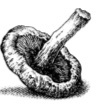Shiitake Mushroom Basics
About Shiitake Mushrooms
The origins of shiitake cultivation have been traced back thousands of years to Japan. People often found these mushrooms growing on downed “shii” trees (this is where the mushroom got its name). People would take the mushroom-clad logs, place them next to logs without mushrooms and simply wait for the wind to disperse the spores. Thankfully, since then, a lot of research in Japan and China has gone into shiitake-growing techniques, and we don’t have to wait for the wind anymore. In fact, shiitake is the second most produced mushroom in the world, following the common button mushroom.

Shiitake Mushrooms (Lentinula edodes) at a glance
Shiitake Form: Fleshy convex cap, slightly tough stalk
Color: light to dark brown cap, creamy white gills, light brown stem
Best grown on: hardwoods like oak, maple, ironwood
Spawn form available: plug, grain, sawdust, thimble
Average size at harvest: 3- to 6- inch diameter cap, 2- to 4- inch stalk
Flavor/aroma: robust, earthy
Why Grow Shiitake
Forest cultivation of shiitake mushrooms can generate income, diversify farm and forestry enterprises, add value to forestry by-products and create opportunities for timber stand improvement. At the time of this publication, log-grown shiitake mushrooms were selling for $10 to $18 per pound throughout New England. (ED NOTE: as of 2022, prices still remain high, see updated markets survey) Independent blind taste tests have found forest-grown shiitakes to be superior in flavor and freshness compared to the sawdust-grown shiitake mushrooms commonly found in supermarkets.
Basics of Shiitake Production
Production involves inoculating fresh cut hardwood logs by placing spawn (cultured fungus) into holes drilled in each log. Logs are then incubated in a “laying yard” under forest shade for about one year before fruiting (mushrooms) begins. The log will continue to fruit biannually for three to four years, generating upwards of 8 ounces of mushrooms at each flush.
Key Terms
Bolts: A log inoculated with spawn.
Flush: A group of mushrooms that fruited within a short period of time after a single forcing event.
Forcing: The process used to trigger the mycelium to produce fruiting bodies (mushrooms) predictably, within a 7- to 14- day period.
Laying Yard: The place where the logs are incubated and routine maintenance is performed. The logs usually remain in the laying yard for the rest of their productive lifetime, which includes both fruiting and harvest.
Mycelium: The vegetative part of a fungus, consisting of a network of fine white filaments (hyphae).
Shocking: Often used interchangeably with “forcing.” Means of triggering shiitake mushroom production (forcing) which involves soaking logs in cold water for an extended period of time (12 to 24 hours) to induce fruiting.
Spawn: Vegetative mycelium (fungal strands, NOT spores), cultured on sawdust and a little grain under sterile conditions, and used to inoculate logs.
Spawn Run: An incubation period bolts undergo after inoculation during which the shiitake mycelium grows through the wood substrate.

